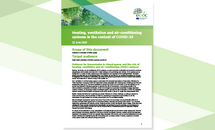
#15,338
While we are over 5 months into our COVID-19 ordeal, there remain a lot things we still don't understand about how it transmits. Most cases are assumed to be infected via large respiratory droplets, derived from relatively close (1-2 meter) contact with an infected individual.
But increasingly the role of smaller, aerosolized particles that can spread farther and linger longer has come under scrutiny, and contaminated fomites are also considered a likely source of infection (see EID Journal: Detection of SARS-CoV-2 on Surfaces in Quarantine Rooms).
How often these alternate routes of infection occur is unknown, but anecdotal evidence suggests they are plausible. The concern over fomites has led to extensive guidance on the cleaning of surfaces and inanimate objects (see CDC Extended Guidance for Cleaning and Disinfecting (Homes, Schools, Businesses, etc.)) and concerns of possible aerosolization has led to guidance on Face covers.
Today the ECDC has released a 5-page technical document on the admittedly limited evidence for the indoor spread of the virus via mechanical means, and provides recommendations on how to limit its impact.
After reviewing a number of field reports, the authors offer the following less-than-firm conclusions:
In conclusion, the available evidence indicates that:
- Transmission of COVID-19 commonly occurs in closed indoor spaces.
- There is currently no evidence of human infection with SARS-CoV-2 caused by infectious aerosols distributed through the ventilation system ducts of HVACs. The risk is rated as very low.
- Well-maintained HVAC systems, including air-conditioning units, securely filter large droplets containing SARS-CoV-2. It is possible for COVID-19 aerosols (small droplets and droplet nuclei) to spread through HVAC systems within a building or vehicle and stand-alone air-conditioning units if air is recirculated.
- Air flow generated by air-conditioning units may facilitate the spread of droplets excreted by infected people longer distances within indoor spaces.
- HVAC systems may have a complementary role in decreasing transmission in indoor spaces by increasing the rate of air change, decreasing recirculation of air and increasing the use of outdoor air.
Despite the current lack of evidence of infection due to ventilation systems , the report goes on to provide guidance to HVAC managers on how to reduce the risk of transmission, including:
Building administrators should maintain heating, ventilation, and air-conditioning systems according to the manufacturer’s current instructions, particularly in relation to the cleaning and changing of filters [17]. There is no benefit or need for additional maintenance cycles in connection with COVID-19. Energy-saving settings, such as demand-controlled ventilation controlled by a timer or CO2 detectors, should be avoided.
Consideration should be given to extending the operating times of HVACs before and after the regular period [17,18].
Direct air flow should be diverted away from groups of individuals to avoid pathogen dispersion from infected subjects and transmission.
Organisers and administrators responsible for gatherings and critical infrastructure settings should explore options with the assistance of their technical/maintenance teams to avoid the use of air recirculation as much as possible [17,18]. They should consider reviewing their procedures for the use of recirculation in HVAC systems based on information provided by the manufacturer or, if unavailable, seeking advice from the manufacturer.
The minimum number of air exchanges per hour, in accordance with the applicable building regulations, should be ensured at all times. Increasing the number of air exchanges per hour will reduce the risk of transmission in closed spaces. This may be achieved by natural or mechanical ventilation, depending on the setting [4,18,19].
By all means, follow the link below to read the report in its entirety.
Heating, ventilation and air-conditioning systems in the context of COVID-19
Technical report
22 Jun 2020
This document aims to provide guidance for public health authorities in EU/EEA countries and the UK on the ventilation of indoor spaces in the context of COVID-19.
Download
Heating, ventilation and air-conditioning systems in the context of COVID-19 - EN - [PDF-405.39 KB]
